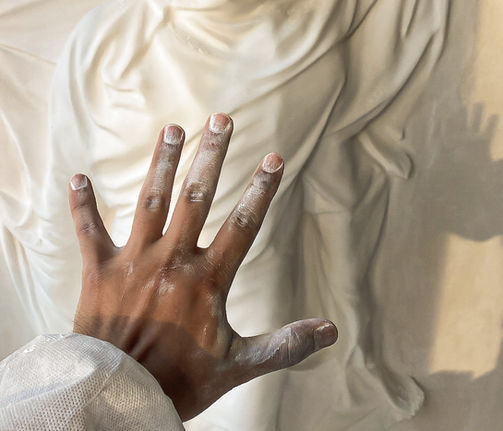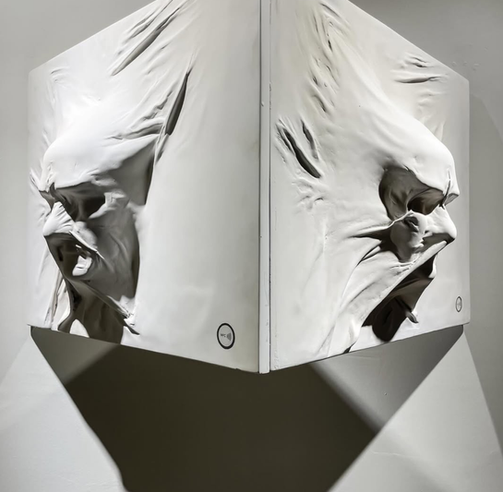
TALKING WALLS SERIES
Talking Walls Series
What if walls could talk?
From the raw cave walls of ancient times to today’s towering glass facades, walls have always watched — silently absorbing every joy, every sorrow, every transformation.
In Talking Walls, Eyüp Can gives form to the emotions that walls might carry if they could finally speak.
Each sculpture reveals a memory — one we’ve all felt, yet rarely express: birth, death, longing, resilience.
These are not just walls. They are emotional landscapes, carved by breath, time, and human presence.
Here, matter remembers.
Here, walls talk.
The FIRST MOMENT of DEATH
From the “Talking Walls” Series
Two thousand years ago, it was the cave walls that saw everything.
Today, the glass walls of corporate towers see it all.
A thousand years from now, it will be the walls of surreal, utopian environments that witness our lives.
If walls could talk, what memories would they release?
Perhaps they would show us our most fragile moments—the extremes of human experience.
From this idea emerges The First Moment of Death, a sculpture that embodies one of life’s most intense, silent transitions—the final breath before stillness.
It stands in contrast with its twin: The First Moment of Birth.
Together, they form a duality—pain and joy, end and beginning, absence and arrival.
It is said that nearly 106 billion humans have lived on this planet. Around 100 billion have already met this moment.
This work speaks for them—and for us.
Dimensions: 125 × 250 cm
Material: Fiberglass, Polyester, Automotive Paint
Creation Time: 7.5 months (Clay Model Phase)
Year: 2022


Walls sway in the wind of breath, and each exhale opens new horizons within us.
The power of breath reminds us of our ability to transcend the boundaries behind walls; every breath is a step toward freedom.
The rhythm of breath invites the walls into a dance—a dance that mirrors our emotions.
Each breath becomes part of an inner choreography; passages of joy, sorrow, fear, and love echo between the walls.
As they move with the soft melody of breath, the walls become a transition space between the many shades of life. 🗽
#talkingwalls
“To see me does not necessarily mean to see my face. If you understand my ideas, my feelings if you truly feel them that is enough.”
— Mustafa Kemal Atatürk
One of the most distinctive aspects of this artwork is that Atatürk’s figure can only be clearly perceived from a specific angle — the one from which the photo was taken. From other angles, the figure appears merely as a human form.This reflects the idea that only those who can view the world through Atatürk’s own perspective — those who can understand his thoughts and emotions — can truly see and feel him.
When we think of childhood, certain characteristic traits come to mind: a free spirit, sincerity, honesty, the ability to always find joy, the openness to receive and show love, and the courage to act naturally. Yet, as time passes, people begin to lose these qualities—perhaps because honesty once brought them pain, or because the weight of social pressure silenced their spontaneity. No matter how powerful, successful, or wealthy a person may become, at the end of the day, when returning home and facing themselves in the mirror, they inevitably encounter their inner child. Around the ages of 6 or 7, the subconscious recalls these defining traits, and one’s conscience is questioned—because this confrontation is essential to being human. In this work, even though the figure in the mirror is the adult self, the one holding up the mirror is the child—symbolizing the 6–7-year-old within who compels us to face ourselves
Over a thousand years ago, Avicenna (Ibn Sina) emphasized the healing power of the sound of water and began using it in treatments. Since then, it has continued to be used in therapies aimed at creating relaxation, refreshment, calmness, and peace.
In the Flow piece, the intention goes beyond sound: it explores how three-dimensional forms can also touch human emotions. Just as the flowing shapes of water surfaces evoke tranquility, this work was designed to bring serenity and freshness into spaces.
Believing in the mystery of the number 7—associated with abundance, peace, and positive energy—Flow comes to life in seven different colors to carry these sensations into your environment.
There are countless ways to express gratitude—each unique in form, yet the energy it radiates never changes. It wraps, embraces, and uplifts everything around it. Gratitude is more than a feeling; it is a state of being that transforms perspective, softens hardships, and magnifies joy. It is the silent force that nurtures connection, allowing light to reach even the darkest corners of the soul. This work embodies the infinite forms of thankfulness, reminding us that while the ways we express it may differ, its essence always remains the same—powerful, unifying, and ever-giving.
The Ark of the Covenant, mentioned in the Qur’an, the Bible, and the Torah, has been hidden and protected behind walls for 2,500 years. This work, part of my Talking Walls series on which I have been working for months, is titled The Ark of the Covenant.























